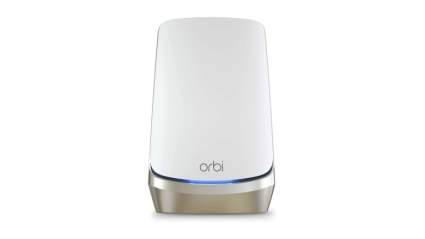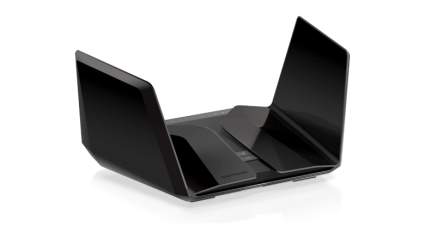
Multi-gig Internet speeds are still a fairly sparse offering but you can get impressive results from ISPs like AT&T, Ziply, Fios, and Google Fiber (if any of those are available in your area). And with the rapid developments in bandwidth that have come in recent years, there is no reason why power users shouldn’t future-proof their home network with a 10Gb router. Yeah, it sounds crazy to me too. In fact, I published an article on the best 1Gb routers only a few years ago. This type of upgrade won’t be easy to achieve though, even if you are already wired up for gigabit. You’ll need all the appropriate hardware for the task, starting with a high-speed router.

|
Amazon Customer Reviews
|
Price: $529.00 Shop at Amazon | Shop now Read our review |

|
Amazon Customer Reviews
|
Price: $419.76 Shop at Amazon | Shop now Read our review |

|
Amazon Customer Reviews
|
Price: $587.00 Shop at Amazon | Shop now Read our review |

|
Amazon Customer Reviews
|
Price: $559.99 Shop at Amazon | Shop now Read our review |

|
Amazon Customer Reviews
|
Price: $270.99 Shop at Amazon | Shop now Read our review |
-
1. EDITOR’S CHOICE: Asus ROG Rapture GT-AXE16000
Pros:- Two 10Gb WAN/LAN ports
- Quad-band wireless
- Link aggregation support for further futureproofing
Cons:- Bulky design
- No SFP+ port
- High price tag
If you are looking for the most souped-up 10Gb router available to consumers, then the Asus ROG Rapture GT-AXE16000 should absolutely be on your radar. It has not just one but two 10GB WAN/LAN ports as well as a 2.5Gb WAN/LAN port. This creates a huge number of possible network configurations, including dual WAN and link aggregation between WAN and LAN4.
To complete the port selection, you also get four 1Gb LAN ports, with link aggregation between ports 1 and 2. Performance wise, this means you can hardwire up to four devices for multi-gig internet. There is no SFP+ support, though, which may be disappointing for those hoping to connect a security gateway or network switch.
The GT-AXE16000 also performs fantastically as a router. It broadcasts quad-band WiFi 6E wireless, which allows it to efficiently support a ludicrous number of clients. And if that power simply isn’t enough, you can add other AiMesh-compatible devices as wireless range extenders or backhaul nodes. It has a robust suite of network settings too, including VPN, port-forwarding, QoS, parental controls, up to three guest networks, and so much more.
Ultimately, the GT-AXE16000 might be overkill for many users. But then again, those considering 10Gb internet are typically far from your average user. A ROG-brand router topped my list of the best routers that use WiFi 6 when 802.11.ax first came out, so it is no surprise that it tops my list of this futuristic tech. Yes, the router is quite pricey but offers such an insane amount of flexibility and power that it will likely continue to be a useful networking tool for the next decade or more.
Frequency bands: one 2.4GHz, two 5GHz, and one 6GHz
Max throughput: 16Gbps
Processor: 1.8GHz 64-bit quad-core
Ethernet ports: four 1Gb ports, two 10Gb WAN/LAN ports, and one 2.5Gb WAN/LAN port
USB ports: one USB 3.0 port and one USB 2.0 port -
2. TP-Link Archer AXE300
Pros:- Two 10Gb WAN/LAN ports
- Quad-band wireless
- VPN support
Cons:- Only one USB port
- Some router features are paywalled
- High price tag
The TP-Link Archer AXE300 offers specs that are highly competitive with my top pick as well as a lower price, making it a highly viable home networking solution for those with access to 10Gb internet. With its dual 10Gb WAN/LAN ports, it can stream full 10-gig speeds over CAT 6A ethernet as well as respectable multi-gig speeds over its WiFi6E network. The AXE300 has quad-band wireless to all but eliminate network congestion. Seriously, you’d have to have an insane number of devices on the network at once to even feel a hiccup.
But the AXE300 isn’t all about the raw throughput. It also has a nice suite of networking features including basic parental controls, QoS, VPN support, and guest network. Some features are locked behind a subscription, though, which some may find annoying. And while I’m griping, I would have loved to see more USB ports on a device like this.
Shortcomings aside, this is probably TP-Link’s best router, and that means something considering they’ve made some great routers for single-Gigabit speeds too. It won’t 100-percent future-proof your home network, but then again, no single piece of tech ever will.
Frequency bands: one 2.4GHz, two 5GHz, and one 6GHz
Max throughput: 15.6Gbps
Processor: 2.0GHz 64-bit quad-core
Ethernet ports: four 1Gb ports, one 10Gb WAN/LAN port, one 10 Gb SFP+/RJ45 WAN/LAN port, and one 2.5Gb WAN/LAN port
USB ports: one USB 3.0 port -
3. Netgear Orbi RBRE960
Pros:- Quad-band wireless
- VPN support
- Easy setup
Cons:- No 10Gb LAN ports
- No USB ports
- High price tag
The Netgear Orbi RBRE960 may be Netgear’s first foray into 10 gig speeds for consumers, but it is certainly not their first high-speed mesh router. User-friendly mesh networks are one of Netgear’s specialties, and as such, the RBRE960 is quite easy to set up.
The Orbi mobile app is the main way to interface with this router. The UI is decent and provides access to advanced features like guest networks, parental controls, and QoS. There are also some premium features that require a subscription. There is a web browser-based portal as well but its features are more limited.
As for its performance, the Orbi RBRE960 supports a max throughput of 10.8Gbps over its quad-band wireless network. Unfortunately, though, this router doesn’t have any 10Gb LAN ports, which means some users may want to upgrade once PCs and other hardwired devices start having built-in 10Gb LAN ports themselves. For now, the one 2.5Gb LAN port and three 1Gb LAN ports will have to suffice. Another disappointment is the lack of USB ports. You could probably still set up a NAS with some wacky adapters… or you could go with one of my higher-rated options.
But while this router falls short on physical connectivity, it still delivers legit 10-gig speeds backed by a user-friendly app, and that counts for something.
Frequency bands: one 2.4GHz, two 5GHz, and one 6GHz
Max throughput: 10.8Gbps
Processor: 2.2GHz 64-bit quad-core
Ethernet ports: Three 1Gb LAN ports, one 2.5Gb LAN port, and one 10Gb WAN/LAN port
USB ports: none -
4. Asus RT-AX89X
Pros:- Two 10Gb WAN/LAN ports
- Eight 1Gb LAN ports
- VPN support
Cons:- Only dual-band WiFi
- 6Gbps max speed over wireless
- Bad mesh support
Whether or not you find value in the Asus RT-AX89X depends on exactly what you’re looking for out of a 10-gig router. Specifically, this router has two 10Gb WAN/LAN ports but only supports a theoretical wireless throughput of 6Gbps. So, while it can support full-speed wired connections with devices that have 10GBase-T and 10G SFP plus networking technology, it won’t be delivering 10-gig speeds over wireless. And for this tradeoff, it is considerably cheaper than the other options I’ve highlighted.
These 10-gig ports aren’t configured for WAN out of the box, though, so you will have to poke through the settings some to set them up that way. The UI for the router gives you easy access to lots of networking options, including parental controls, QoS, guest networks, and VPN (for the whole network only). The mesh support is fairly spotty too.
Considering that this router can still support multi-gig wireless speeds with other WiFi 6 devices, it is still no slouch on speed. But, there’s no denying that it is already outclassed by newer and more expensive routers. It emits a dual-band wireless signal that has some pretty solid range thanks to its eight adjustable antennas. It has a fairly potent CPU too. It also has 8 additional gigabit ethernet ports.
In a lot of ways, the RT-AX89X feels more like a network switch than a router. But it is still a solid way to prepare your home network for the arrival of 10-gig devices.
Frequency bands: one 2.4GHz and one 5GHz
Max throughput: 6Gbps
Processor: 2.2GHz 64-bit quad-core
Ethernet ports: four 1Gb ports, two 10Gb WAN/LAN ports, and one 2.5Gb WAN/LAN port
USB ports: one USB 3.0 port and one USB 2.0 port -
5. Netgear Nighthawk RAXE500
Pros:- Tri-band wireless
- VPN support
- Supports multi-gig speeds
- Link aggregation support
Cons:- Only supports 2 Gig Internet max
- Tricky setup
- High price tag
To start, I should say that the Netgear Nighthawk RAXE500 isn’t technically capable of true 10 gig speeds. That said, it still offers top-tier multi-gig wireless performance and will still be a “future-proof” router in areas that are years away from 10-gig plans. In this case, the bottleneck in this router is the 2.5Gb WAN/LAN port, which means that the device can only really support 2.5Gb internet speeds. But that’s still multi-gig speeds and this is still a highly capable router.
This router uses the latest WiFi6E wireless protocol and has a tri-band network to practically eliminate local traffic between devices. You get a full suite of networking features too, including Guest WiFi access, DoS protection, QoS, Firewall settings, VPN support, and more. Note that some of the more useful features like IPv6 and MU-MIMO are disabled by default, which complicates setup.
I’m surprised that Netgear is lagging hard on the 10Gb router on the market, especially since I know this brand makes one of the best DOCSIS 3.1 cable modems (which is an accessory you won’t need since 10 gig internet can only be delivered through an Optical Network Terminal). That said, I consider this recommendation a decent placeholder option until we see more 10Gb routers from Netgear.
Frequency bands: one 2.4GHz, one 5GHz, and one 6GHz
Max throughput: 10.8Gbps
Processor: 1.8GHz triple-core
Ethernet ports: four 1Gb LAN ports, one 1Gb LAN port for link aggregation, and one 2.5Gb WAN/LAN port
USB ports: two USB 3.2 ports
How to Get 10Gb Internet
Considering that 10Gb Internet speeds are only available in select metropolitan areas at the moment, you must make sure you have access to both 10-Gig service and 10-Gig hardware before you try to get the top speed of Internet. And that means getting more than just a 10Gb router.
Essentially, you need to check each device in your home network for technological bottlenecks or else you'll end up with reduced speeds That means your routers have to be WiFi 6-compatible as well as any cables (CAT6 supports 10Gb/s up to 100 meters and CAT6A supports 10Gb/s across any distance) and even devices
Yes, you need to check each individual device on your network for compatibility with 10Gb speeds. That means it needs either needs WiFi 6 compatibility or to have a 10Gb/s ethernet port attached. You can upgrade some computers using a WiFi 6 wireless adapter but you can expect most older devices to be permanently incompatible with 10Gb speeds.
How Fast is 10 Gig Internet, Really?
If you think that a promise like 10 Gigabit speeds is too good to be true, then pat yourself on the back because you are technically correct. Because of just how many factors affect your Internet speeds, it will be almost impossible to get a full 10Gb/s to your home devices.
For starters, these speeds are measured from a number of points depending on if you have fiber to the premises or node. This concept is explained in further detail in this article from Utopia Fiber. The takeaway is that a certain amount of speed degradation is to be expected just getting to the home.
Then, wirelessly transmitting your signal throughout the home will leave you subject to the layout of your home. WiFi 6 is physically capped at 9.6 Gb/s too, so even if you had a perfect wireless setup it will still be short of the goal. You could mitigate this by hardwiring devices via CAT6A cable but I don't currently have a single device with a 10Gb/s LAN port in my house.
When Will 10Gb Become Mainstream?
If you aren't in an area that currently offers 10Gb WiFi, then there is really no telling how long it may take to arrive in your town. However, one news writer over at Tom's Hardware asserts that it will become a mainstream technology within a decade.
It will likely arrive alongside the innovation of DOCSIS 4.0 and Hybrid Fiber-Coaxial connections, both of which are currently in development.